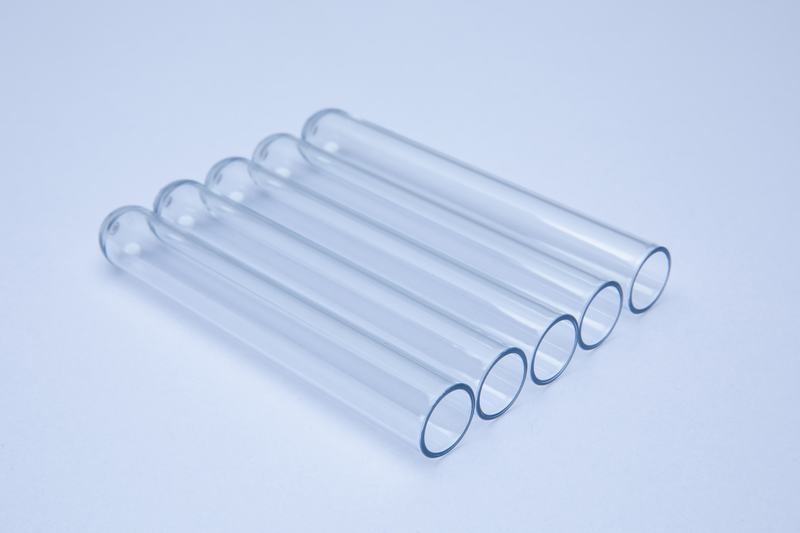The Importance of Properly Sealing Pet Test Tubes: Ensuring Safety and Reliability in Veterinary Testing
Published:
Sep 27,2023
Classification:
Discover the significance of correctly sealing pet test tubes to ensure the accuracy, safety, and reliability of veterinary testing procedures. This comprehensive guide explores the importance of prop

Table of Contents:
1. Introduction
2. Understanding the Significance of Properly Sealing Pet Test Tubes
3. Common Challenges in Sealing Pet Test Tubes
4. Best Practices for Properly Sealing Pet Test Tubes
5. The Role of Sealing in Ensuring Safety and Accuracy in Veterinary Testing
6. FAQs (Frequently Asked Questions)
7. Conclusion
When it comes to veterinary testing, the importance of properly sealing pet test tubes cannot be overstated. Ensuring the accuracy and reliability of test results is crucial not only for accurate diagnoses but also for the well-being of our beloved animal companions. This article aims to shed light on the significance of proper sealing techniques, common challenges faced, and best practices to optimize testing outcomes.
Properly sealing pet test tubes is essential for maintaining the integrity of samples during transportation and analysis. This process helps prevent contamination, evaporation, and degradation of the collected specimen. By creating an airtight seal, we can preserve the sample's properties, such as temperature, pH levels, and chemical composition, ensuring accurate test results.
Improper sealing can lead to compromised test results, jeopardizing the accuracy of diagnoses and treatment plans. Contamination from external factors, such as bacteria or air pollutants, can introduce false positives or misleading readings. Additionally, inadequate sealing may cause evaporation or leakage of the sample, altering its concentration and affecting the reliability of test outcomes.
Properly sealed pet test tubes contribute to the long-term stability of samples, enabling storage over extended periods without compromising their integrity. This is particularly important for tests requiring multiple analyses or those conducted over time, such as monitoring chronic diseases or tracking treatment efficacy. By maintaining sample stability, veterinarians can accurately track the progress of their patients' conditions and adjust treatment plans accordingly.
Sealing pet test tubes can present various challenges that need to be addressed to ensure optimal test results. Understanding and overcoming these challenges is crucial for accurate and reliable veterinary testing.
One common challenge is selecting sealing materials that are compatible with the specific test requirements. Different tests may necessitate specific materials, such as rubber stoppers, caps, or specialized seals, to maintain the integrity of the sample. Veterinarians and laboratory professionals must carefully assess the compatibility of sealing materials to prevent any unwanted interactions or compromises in the sample's properties.
Another challenge lies in establishing standardized sealing techniques across veterinary practices and laboratories. Consistency in sealing procedures minimizes variations in test results, ensuring reliable comparisons and interpretations. Developing and adhering to industry-wide guidelines for sealing pet test tubes promotes consistency, accuracy, and the overall quality of veterinary testing.
To ensure the optimal sealing of pet test tubes, following best practices is essential. By implementing these guidelines, veterinary professionals can improve the reliability and accuracy of test results.
Before sealing, thoroughly clean and prepare the test tubes to eliminate any potential contaminants. Use appropriate cleaning agents and ensure they are rinsed and dried properly to prevent residue from interfering with the sample or sealing process.
Choose sealing materials that are compatible with the specific tests being conducted. Consider the sample's properties, storage conditions, and any specific requirements outlined by the test manufacturer. This ensures an airtight seal and prevents any unwanted interactions or compromises during transportation or analysis.
Adopt a standardized sealing technique to maintain consistency across laboratory procedures. Whether using rubber stoppers, caps, or specialized seals, ensure a secure fit that creates an airtight seal. Avoid over or under-tightening, as this may compromise the integrity of the sample or lead to leakage.
Accurate labeling and documentation of sealed pet test tubes are crucial for traceability and result interpretation. Clearly identify each tube with relevant information, such as patient details, date of collection, and specific tests to be conducted. This facilitates efficient tracking, reduces errors, and ensures the reliability of test results.
Properly sealing pet test tubes plays a pivotal role in ensuring the safety and accuracy of veterinary testing procedures. By preserving the integrity of the sample, sealing contributes to:
- Reliable diagnoses and treatment plans
- Minimized risk of contamination and false positives
- Long-term stability of samples for future analysis
- Consistency and standardization in testing procedures
Q1: Can improper sealing affect the accuracy of test results?
Q2: What are the consequences of contamination in pet test tubes?
Q3: Are there any specific materials recommended for sealing pet test tubes?
Q4: How can I ensure the compatibility of sealing materials with specific tests?
Q5: Can inadequate sealing cause evaporation or leakage of the sample?
Properly sealing pet test tubes is of utmost importance in veterinary testing. This article has highlighted the significance of proper sealing techniques, common challenges faced, and best practices to optimize testing outcomes. By implementing these guidelines, veterinary professionals can ensure the accuracy, reliability, and safety of their diagnostic procedures, ultimately contributing to the well-being of our beloved pets.
1. Introduction
2. Understanding the Significance of Properly Sealing Pet Test Tubes
3. Common Challenges in Sealing Pet Test Tubes
4. Best Practices for Properly Sealing Pet Test Tubes
5. The Role of Sealing in Ensuring Safety and Accuracy in Veterinary Testing
6. FAQs (Frequently Asked Questions)
7. Conclusion
1. Introduction
When it comes to veterinary testing, the importance of properly sealing pet test tubes cannot be overstated. Ensuring the accuracy and reliability of test results is crucial not only for accurate diagnoses but also for the well-being of our beloved animal companions. This article aims to shed light on the significance of proper sealing techniques, common challenges faced, and best practices to optimize testing outcomes.
2. Understanding the Significance of Properly Sealing Pet Test Tubes
Properly sealing pet test tubes is essential for maintaining the integrity of samples during transportation and analysis. This process helps prevent contamination, evaporation, and degradation of the collected specimen. By creating an airtight seal, we can preserve the sample's properties, such as temperature, pH levels, and chemical composition, ensuring accurate test results.
2.1 The Impact of Improper Sealing on Test Results
Improper sealing can lead to compromised test results, jeopardizing the accuracy of diagnoses and treatment plans. Contamination from external factors, such as bacteria or air pollutants, can introduce false positives or misleading readings. Additionally, inadequate sealing may cause evaporation or leakage of the sample, altering its concentration and affecting the reliability of test outcomes.
2.2 Ensuring Long-Term Stability of Samples
Properly sealed pet test tubes contribute to the long-term stability of samples, enabling storage over extended periods without compromising their integrity. This is particularly important for tests requiring multiple analyses or those conducted over time, such as monitoring chronic diseases or tracking treatment efficacy. By maintaining sample stability, veterinarians can accurately track the progress of their patients' conditions and adjust treatment plans accordingly.
3. Common Challenges in Sealing Pet Test Tubes
Sealing pet test tubes can present various challenges that need to be addressed to ensure optimal test results. Understanding and overcoming these challenges is crucial for accurate and reliable veterinary testing.
3.1 Compatibility of Sealing Materials
One common challenge is selecting sealing materials that are compatible with the specific test requirements. Different tests may necessitate specific materials, such as rubber stoppers, caps, or specialized seals, to maintain the integrity of the sample. Veterinarians and laboratory professionals must carefully assess the compatibility of sealing materials to prevent any unwanted interactions or compromises in the sample's properties.
3.2 Standardization of Sealing Techniques
Another challenge lies in establishing standardized sealing techniques across veterinary practices and laboratories. Consistency in sealing procedures minimizes variations in test results, ensuring reliable comparisons and interpretations. Developing and adhering to industry-wide guidelines for sealing pet test tubes promotes consistency, accuracy, and the overall quality of veterinary testing.
4. Best Practices for Properly Sealing Pet Test Tubes
To ensure the optimal sealing of pet test tubes, following best practices is essential. By implementing these guidelines, veterinary professionals can improve the reliability and accuracy of test results.
4.1 Cleaning and Preparation of Test Tubes
Before sealing, thoroughly clean and prepare the test tubes to eliminate any potential contaminants. Use appropriate cleaning agents and ensure they are rinsed and dried properly to prevent residue from interfering with the sample or sealing process.
4.2 Selecting the Right Sealing Material
Choose sealing materials that are compatible with the specific tests being conducted. Consider the sample's properties, storage conditions, and any specific requirements outlined by the test manufacturer. This ensures an airtight seal and prevents any unwanted interactions or compromises during transportation or analysis.
4.3 Proper Technique for Sealing Pet Test Tubes
Adopt a standardized sealing technique to maintain consistency across laboratory procedures. Whether using rubber stoppers, caps, or specialized seals, ensure a secure fit that creates an airtight seal. Avoid over or under-tightening, as this may compromise the integrity of the sample or lead to leakage.
4.4 Labeling and Documentation
Accurate labeling and documentation of sealed pet test tubes are crucial for traceability and result interpretation. Clearly identify each tube with relevant information, such as patient details, date of collection, and specific tests to be conducted. This facilitates efficient tracking, reduces errors, and ensures the reliability of test results.
5. The Role of Sealing in Ensuring Safety and Accuracy in Veterinary Testing
Properly sealing pet test tubes plays a pivotal role in ensuring the safety and accuracy of veterinary testing procedures. By preserving the integrity of the sample, sealing contributes to:
- Reliable diagnoses and treatment plans
- Minimized risk of contamination and false positives
- Long-term stability of samples for future analysis
- Consistency and standardization in testing procedures
6. FAQs (Frequently Asked Questions)
Q1: Can improper sealing affect the accuracy of test results?
Q2: What are the consequences of contamination in pet test tubes?
Q3: Are there any specific materials recommended for sealing pet test tubes?
Q4: How can I ensure the compatibility of sealing materials with specific tests?
Q5: Can inadequate sealing cause evaporation or leakage of the sample?
7. Conclusion
Properly sealing pet test tubes is of utmost importance in veterinary testing. This article has highlighted the significance of proper sealing techniques, common challenges faced, and best practices to optimize testing outcomes. By implementing these guidelines, veterinary professionals can ensure the accuracy, reliability, and safety of their diagnostic procedures, ultimately contributing to the well-being of our beloved pets.





